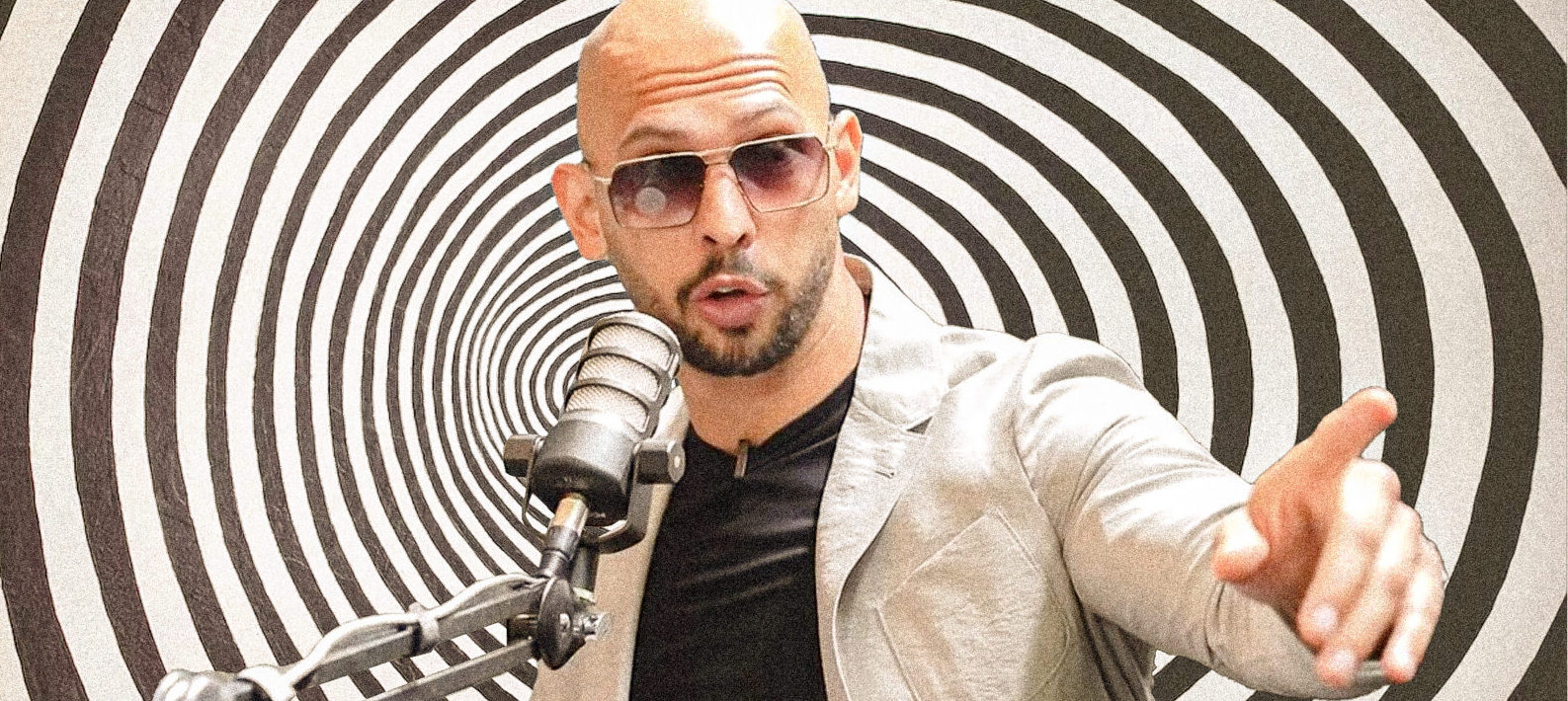- You have no items in your shopping cart
- Subtotal: ₹0.00

Andrew Tate is one of the most talked-about personalities online. Whether you love him or hate him, there’s one thing every content creator wants to know: what mic does Andrew Tate use?
If you’re trying to start a podcast, record videos, or improve your audio setup, knowing what top influencers use is key.
In this article, we’re giving you the exact answer, a full breakdown of his setup, and a recommendation that works for beginners and pros alike.
Let’s get started and give the answers to your questions:
What Mic Does Andrew Tate Use?
Andrew Tate has publicly stated that he uses the Samson G-Track Pro USB microphone for recording his voice. This confirmation comes directly from his verified Backstage.com profile, where he lists it under his self-recording equipment.
Alongside the mic, he also uses Adobe Audition for editing his audio, demonstrating that he values both clarity and professional sound control.
Why This Matters
- The Samson G-Track Pro is a USB condenser microphone, meaning it’s plug-and-play, with no need for mixers or audio interfaces.
- It offers studio-quality audio with built-in instrument input, perfect for creators who want a clean setup.
- It’s widely used by YouTubers, podcasters, and streamers who want broadcast-level sound without the learning curve of complex gear.
If you’re a content creator looking for crisp audio with minimal setup, the Samson G-Track Pro is one of the most trusted choices on the market, and now you know Andrew Tate uses it too.
Andrew Tate’s Microphone Evolution
While Andrew Tate currently uses the Samson G-Track Pro, his microphone journey has evolved over time based on the content type, location, and production needs. Here is a timeline-style breakdown of the microphones he’s been associated with, backed by public podcast appearances, interviews, and verified gear discussions.
Early Podcast Setup, MXL BCD‑1 + Focusrite Scarlett 6i6
In his early podcasting days, Andrew Tate used the MXL BCD‑1 dynamic broadcast microphone, paired with a Focusrite Scarlett 6i6 interface.
- Ideal for untreated rooms and basic podcast setups
- The Scarlett 6i6 gave him more control over sound levels.
- Quality: Good for starters, but required some technical know-how.w
Intermediate Setup Shure SM7 B + FetHead Preamp
As his content matured, Tate upgraded to the Shure SM7 B, one of the most recognized mics in the podcast industry. He used it with a FetHead inline preamp to boost the signal cleanly.
- Deeper vocal tone, excellent background noise rejection
- Great for YouTube videos and longer podcast episodes
- Needs an audio interface and a gain booster for optimal use
Professional Studio Phase Slate Condenser Mic + Slate Preamp
Once he moved to a professional studio setup, Tate switched to a Slate condenser microphone, powered by a Slate preamp and emulation plugins.
- Broadcast-grade clarity, low-noise, and pristine sound
- Suitable for isolated studios with acoustic treatment
- Best used by professionals with full recording knowledge
On-the-Street Interviews Sennheiser Wireless Lav Mic (G2 Series)
For mobile interviews and street-style videos (e.g., “This Place Rules”), Andrew used a Sennheiser G2 wireless lavalier mic.
- Clip-on mic, discreet and highly portable
- Used with wireless transmitters for freedom of movement
- Trusted by journalists and field interviewers
In summary, Andrew Tate has experimented with multiple professional-grade microphones. However, for personal recording, the Samson G-track remains his go-to choice, likely because of its convenience, quality, and simplicity.
Why Andrew Tate Uses the Samson G-Track Pro
Andrew Tate’s endorsement of the Samson G-Track Pro isn’t just a random pick; it’s a strategic choice based on performance, convenience, and reliability. Let’s break down why he chose this mic over more complex studio gear.
1. Plug-and-Play Convenience
Unlike the Shure SM7 B or Slate condenser setups, the G-Track Pro doesn’t require an audio interface, mixer, or external preamp.
- USB connection makes it ideal for quick setups
- Perfect for remote interviews, podcast recordings, or solo content
- No complicated routing or gear setup, just connect and record
2. Built-in Audio Interface
One of the G-Track Pro’s biggest advantages is its integrated audio interface, which means:
- You can plug in instruments (like a guitar or keyboard) directly
- Monitor your voice in real-time with zero latency.
- Eliminate the need for third-party recording hardware.
This makes it ideal for content creators, musicians, and streamers who want quality without clutter.
3. Multi-Pattern Recording Flexibility
The microphone features three selectable pickup patterns:
- Cardioid: Best for voiceovers and podcasting
- Omnidirectional: For group discussions
- Bidirectional: Great for face-to-face interviews
Andrew Tate likely uses the cardioid mode to capture focused vocals while minimizing background noise.
4. Portability & Reliability
Whether he’s traveling, recording from a temporary studio, or jumping into last-minute sessions, the G-Track Pro is a reliable travel companion.
- No fragile accessories or bulky gear needed.
- Rugged build and premium components
- Easy to pack and deploy within minutesFinal Reason: It Works
Andrew Tate is known for efficiency and results. The Samson G-Track Pro delivers broadcast-quality sound without the headache, and that aligns with his direct, no-nonsense style.
“I use a Samson G-Track Pro microphone for recording and use Adobe Audition for editing.”
From Andrew Tate’s official Backstage.com profile

Samson G-Track Pro Tech Specs & Features
The Samson G-Track Pro isn’t just a mic; it’s a full-featured audio workstation in one device. Below is a clear, organized breakdown of its technical specifications and why they matter for creators like Andrew Tate.
Key Specifications
| Feature | Details |
| Microphone Type | USB Condenser Microphone |
| Bit Depth / Sample Rate | 24-bit / 96kHz |
| Pickup Patterns | Cardioid, Omnidirectional, Bidirectional |
| Built-in Interface | Yes, with 1/4” Instrument Input + Mixer Control |
| Monitoring | Zero-latency headphone output with volume control |
| Frequency Response | 50Hz–20kHz |
| Construction | Die-cast metal body with heavy-duty mesh grille |
| Power Supply | USB Bus Powered (No external power required) |
| Compatibility | Plug-and-play with Windows & macOS |
Why These Features Matter
- 24-bit/96kHz Recording Quality
Get professional, high-resolution audio with every session, ideal for podcasting, vocals, or streaming. - Selectable Polar Patterns
Versatility to record solo, duet, or roundtable formats without buying multiple mics. - Instrument Input
Plug in a guitar, keyboard, or line-level device, perfect for multi-use creators. - Built-in Mixer Controls
Adjust mic/instrument levels on the fly. No need to open the software every time. - Zero-Latency Monitoring
Hear exactly what you’re recording in real-time. No lag, no surprises.
Designed for Serious Creators
The G-Track Pro is more than enough for solo creators, YouTubers, coaches, and streamers. And since Andrew Tate uses it for professional-grade voice work, that’s a strong testament to its real-world performance.
Samson G-Track Pro vs Shure SM7 B: Which Is Better?
Many creators look at Andrew Tate’s microphone setup and wonder:
“Should I use the Samson G-Track Pro or invest in something like the Shure SM7B?”
Both mics are excellent, but they’re built for different purposes and types of users. Here’s a direct comparison to help you choose the right one.
Overview
| Feature | Samson G-Track Pro | Shure SM7B |
| Mic Type | USB Condenser Microphone | XLR Dynamic Microphone |
| Connection | USB (Plug-and-play) | XLR (Needs audio interface + preamp) |
| Setup Complexity | Very Simple | Requires professional setup |
| Recording Quality | Excellent for solo content & podcasting | Broadcast-grade vocal depth |
| Pickup Pattern | Cardioid, Omni, Bidirectional | Cardioid only |
| Use Case | Podcasts, YouTube, Streaming, Remote Interviews | Music, Broadcasting, Pro Podcast Studios |
| Price Range | Affordable | Expensive + gear required |
Choose Samson G-Track Pro If
- You want a plug-and-play setup with minimal gear
- You record solo podcasts, video content, or online coaching.
- You need something portable and beginner-friendly
- You want to save on gear like mixers, interfaces, and preamps.
Andrew Tate uses this mic for personal recording because it’s quick, efficient, and reliable.
Choose the Shure SM7 B If
- You have a dedicated studio setup
- You want maximum vocal depth and tone control.
- You’re comfortable using audio interfaces, preamps, and DAWs
- You’re producing high-end, multi-speaker podcasts or music tracks.ks
Note: Without a FetHead or Cloudlifter, the SM7B’s signal is often too weak.
Both microphones are excellent, but they serve different creators.
If you’re looking for Tate’s exact gear that’s efficient and portable:
Get the Samson G-Track Pro.
If you’re building a professional studio from scratch and have the budget:
Consider the Shure SM7 B setup; just know it comes with extra costs.
Final Thoughts: Should You Buy Andrew Tate’s Mic?
If you’re serious about improving your audio quality without spending thousands on studio gear, then yes, you should strongly consider buying the Samson G-Track Pro.
Trusted by High-Level Creators Like Andrew Tate
This mic isn’t a random pick; it’s the exact microphone Andrew Tate uses for his content. When someone with their audience reach chooses a tool, it’s worth paying attention.
Professional Sound Without the Headache
- No need for mixers, preamps, or interfaces
- Delivers clean, studio-quality vocals
- Great for podcasts, YouTube, coaching, voiceovers, and interviews
- Works right out of the box, just plug it into your USB port.
High Value, Low Risk
Compared to the Shure SM7B setup (which can cost over $600+ with required accessories), the G-Track Pro offers professional-level performance at a fraction of the cost.
And if you’re a beginner, mid-level creator, or even a professional who needs a reliable, portable mic for quick deployment
Get the Samson G-Track Pro.
It’s simple, powerful, and proven by real creators like Andrew Tate.
Because if It Works for Andrew Tate, It’ll Work for You
Whether you’re podcasting, coaching, or creating content, this is your mic upgrade moment.
Does Andrew Tate still use the Samson G-Track Pro?
Yes, Andrew Tate has publicly listed the Samson G-Track Pro as his current microphone for personal recording, according to his verified Backstage.com profile. While he has used other mics in studio setups, the G-Track Pro remains his go-to for self-recorded content.
Is the Samson G-Track Pro good for beginners?
Absolutely. This mic is one of the best USB options for beginners and intermediate creators. It’s plug-and-play, has professional sound quality, and doesn’t require an interface, mixer, or any advanced audio gear.
Can I use the Samson G-Track Pro for YouTube and podcasting?
Yes. The G-Track Pro is widely used by YouTubers, streamers, and podcasters. It delivers crisp vocals, supports multiple recording patterns, and includes a built-in interface for direct instrument input.
How does the G-Track Pro compare to more expensive mics like the SM7 B?
While the Shure SM7 B may offer a deeper vocal tone and slightly better noise control, it also requires a complex setup and extra gear. The G-Track Pro offers 90% of the quality at a fraction of the cost, with a much easier setup.
Which mic does Andrew Tate use?
Andrew Tate use Samson G-Track Pro microphone for recording and use Adobe Audition for editing.



